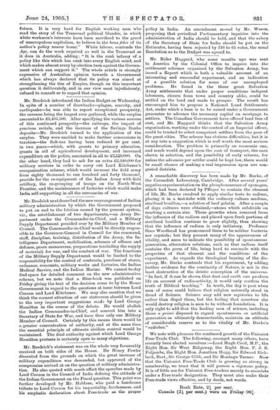Mr. Brodrick next described the new rearrangement of Indian military
administration by which the Government proposed to put an end to the friction caused by the present system, viz., the establishment of two departments,—an Army De- partment under the Commander-in-Chief, and a Military Supply Department presided over by the Military Member of Council. The Commander-in-Chief would be directly respon- sible to the Governor-General in Council for the command, staff, discipline, training, distribution of the Army, the In- telligence Department, mobilisation, schemes of offence and defence, peace manoeuvres, preparations (excluding the supply of material) for war, and the conduct of war. The functions of the Military Supply Department would be limited to the responsibility for the control of contracts, purchase of stores, ordnance, remounts, military works and factories, the Indian Medical Service, and the Indian Marine. We cannot to-day find space for detailed comment on the new administrative scheme, but we note that a Blue-book was published on Friday giving the text of the decision come to by the Home Government in regard to the questions at issue between Lord Curzon and Lord Kitchener. We may also mention that we think the earnest attention of our statesmen should be given to the very important suggestions mad3 by Lord George Hamilton in the course of the debate. He would abolish the Indian Commander-in-Chief, and convert him into a Secretary of State for War, and have thus only one Military Member of Council. Certainly by this means there would be a greater concentration of authority, and at the same time the essential principle of ultimate civilian control would be maintained. The dual authority against which Lord George Hamilton protests is certainly open to many objections.


















































 Previous page
Previous page